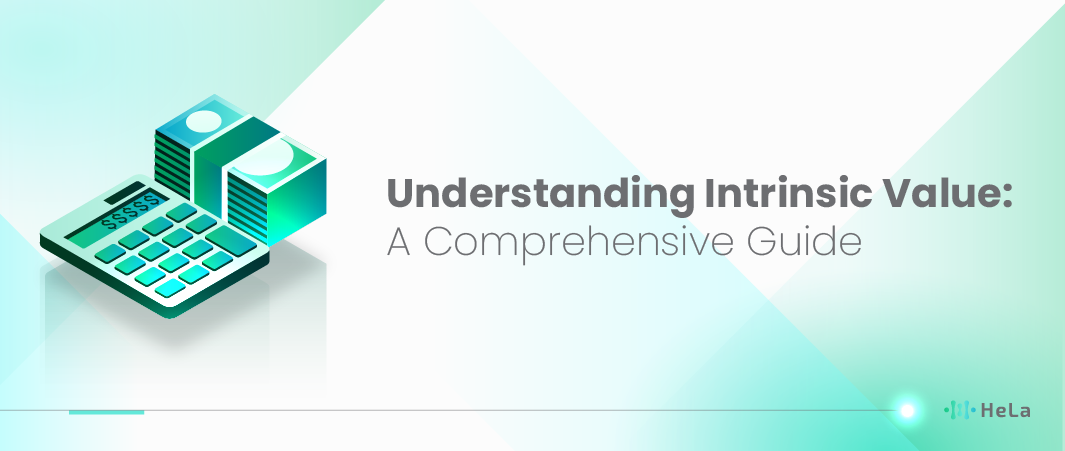The role of intrinsic value in long-term investment strategies is essential for any investor looking to make intelligent and profitable decisions. Intrinsic value is a fundamental concept that represents the true worth of an asset, not just based on its current market price but through a deep analysis of its financial performance, growth prospects, and associated risks. By understanding intrinsic value, you can identify investment opportunities that are overlooked by most people and take more strategic steps.
Determining intrinsic value requires a comprehensive approach and various methods, such as Discounted Cash Flow (DCF) and the Dividend Discount Model (DDM). These methods help you calculate the true worth of an asset based on projected future cash flows and expected dividends. With accurate information and thorough analysis, you can make more focused and profitable investment decisions, avoiding the traps of misleading market speculation.
Don’t miss the opportunity to become a wiser and more successful investor. Start now and see how the concept of intrinsic value can transform your investment approach to be smarter and more effective by reading our article below.
What is Intrinsic Value?

Intrinsic value definition is really a concept that looks at the real value of an asset with reference to its current market value. This is a very important concept for investors who would wish to make their decisions from a more strategic viewpoint rather than from the market trends. The various factors that are covered in the intrinsic value include overall corporate financial health, potential for growth, and current economic environment in which a firm operates. Through these elements, the investor is able to see where the market price of an asset is not properly aligned with its actual worth, whether such an asset hitherto was under-priced or overpriced.
In computing the intrinsic value, the common techniques include fundamental analysis where investors look at the balance sheets, the quality of management, and the nature of industry. The most appropriate financial ratios and ratios of earnings, revenue, and cash flow are used to assess the prospects of a company. It also provides a deep and exhaustive study of the property, which allows investors to focus on an asset’s underlying value and not be swayed by emotion or herd instinct.
One of the most popular methods to calculate intrinsic value is the Discounted Cash Flow (DCF) model. This approach estimates the value of an investment based on its expected future cash flows, which are then discounted back to their present value using a discount rate. The discount rate typically reflects the risk associated with the investment. By applying the DCF model, investors can derive a more accurate estimate of what an asset is truly worth, providing a solid foundation for making investment choices.
Understanding intrinsic value not only empowers investors to make better decisions but also helps them remain calm during market volatility. When you know the intrinsic value of your investments, short-term price fluctuations become less concerning because your decisions are grounded in a deeper understanding of the asset’s true worth. This approach fosters long-term thinking and helps investors stay focused on their financial goals, ultimately leading to more consistent and successful investment outcomes.
Intrinsic Value Importance in Investing

Understanding the importance of intrinsic value in investing is crucial for making smarter and more informed decisions. Intrinsic value provides an insight into the true worth of an asset, beyond its fluctuating market price. By understanding intrinsic value, investors can identify whether an asset is overvalued or undervalued, enabling them to buy at the right price and sell when the asset reaches or exceeds its fair value.
In the context of investing, intrinsic value helps investors focus on the fundamental aspects of the asset. For instance, when analyzing stocks, investors look not only at the current stock price but also at the company’s financial statements, business model, and growth prospects. This approach allows investors to make decisions based on solid data and strong logic, avoiding the pitfalls of market emotions that are often volatile and irrational.
Also Read: Bitcoin Sentiment for Investment Strategies
Furthermore, understanding intrinsic value instills confidence in investors. During market volatility, investors focused on intrinsic value are less swayed by short-term fluctuations. They have the conviction that the assets they hold have a higher value than the current market price reflects. This makes them more resilient and able to stay invested for the long term, waiting for the market to recognize the true value of their assets.
The importance of intrinsic value is also evident in renowned investment strategies such as value investing. Famous investors like Warren Buffett have proven that by focusing on intrinsic value, they can achieve outstanding investment success. Intrinsic value enables investors to uncover opportunities overlooked by the market, buying quality assets at lower prices and enjoying greater profits over time. With a strong understanding of intrinsic value, investors can plan and achieve their financial goals more effectively and efficiently.
Methods to Calculate Intrinsic Value

Calculating the intrinsic value of an asset is a crucial step for investors looking to understand the true worth of their investments. One commonly used method is the Discounted Cash Flow (DCF). DCF calculates the present value of all expected future cash flows from the asset. The basic formula for DCF is:
DCF = CF1(1+r)1 + CF2(1+r)2 + …. + CFn(1+r)n
Here, CF represents the expected cash flows in each period, r is the discount rate reflecting the investment’s risk, and n is the number of periods in the projection. This method allows investors to assess the present value of an investment based on expected future cash flows, providing a more accurate view of an asset’s intrinsic value.
In addition to DCF, there is the Dividend Discount Model (DDM), often used to evaluate dividend-paying stocks. DDM calculates the present value of all expected dividends from the stock. The formula for DDM can be expressed as:
DDM = t = 1Dt(1+r)t
Here, Dtrepresents the expected dividends in year t, and r is the relevant discount rate. This method is suitable for assessing stocks that provide stable and reliable dividends, considering the potential passive income from dividends in determining the intrinsic value of a stock.
In addition to these methods, the Price to Earnings (P/E) ratio is often used to evaluate stock valuations based on comparing the market price of a stock to its earnings per share. The P/E ratio formula is:
P/E = Market Price per ShareEarnings per Share
A high P/E ratio may indicate optimistic market valuation of a company, while a low P/E ratio may suggest that the stock is undervalued. Comparative analysis also provides a more comprehensive view of stock valuations based on financial performance and valuations of similar companies in the same industry.
By understanding and mastering these various methods, investors can calculate and evaluate the intrinsic value of assets in more detail and accuracy. The precise application of these methods allows investors to make smarter and timely investment decisions, optimizing long-term profit potential in investing.
Factors Influencing Intrinsic Value

The intrinsic value of an asset is influenced by various factors that reflect its performance, prospects, and associated risks. One of the main factors is the company’s financial performance. This includes revenue, net income, cash flow, and debt levels. Strong financial performance typically indicates that the company can generate consistent profits and manage its debt well, positively impacting its intrinsic value.
Another significant factor is the company’s growth prospects. This involves analyzing how the company will develop in the future, including product innovation, market expansion, and operational efficiency improvements. High growth prospects usually increase intrinsic value because investors expect higher revenues and profits in the future. For example, technology companies that continue to innovate and expand their customer base often have higher intrinsic values.
Macroeconomic conditions also play a crucial role in determining intrinsic value. Factors such as interest rates, inflation, and overall economic growth can affect a company’s performance and consumer purchasing power. For instance, low-interest rates can boost business investment and consumption, while high inflation can reduce consumer purchasing power and increase a company’s operational costs. Investors must consider these factors when assessing an asset’s intrinsic value.
Also Read: Store Of Value: The Role and The Landscape
Additionally, risks associated with a particular company or industry also affect intrinsic value. These risks can include business risks, such as market demand uncertainty or operational issues, as well as external risks, such as regulatory changes or geopolitical conditions. Companies that can effectively manage and mitigate these risks tend to have higher intrinsic values. Conversely, companies with high risks and significant uncertainties usually have lower intrinsic values. Understanding and comprehensively evaluating all these factors is key to determining an accurate intrinsic value and making wiser investment decisions.
Benefits of Intrinsic Value
Using the concept of intrinsic value in investing offers several important benefits that can help investors make more informed and strategic decisions. Here are some of the main advantages of understanding and applying intrinsic value:
Identifying Investment Opportunities
One of the key advantages of the application of intrinsic value lies in the possibility to define under-or overestimated assets. Using the worth or price ratio, an investor can compare the intrinsic value of a security with its market price and decide whether the security is undervalued or overvalued.
A low price to earnings may reveal buying opportunities if securities have sunk to below their worth while a high price to earnings may suggest selling time or staying away from the security. Therefore, the idea of intrinsic value is to assist the investor in identifying markets where they may not be fully valued or evaluated.
More Rational Decision-Making
Concept of genuine assets imparts the knowledge that investors must rely on theoretical analysis and not get influenced by stock prices swings or get involved in speculative bubbles. Appraising the company’s financial standing, its future prospects, and other key characteristics enable the rational and informed approach to investments.
It minimizes mistakes in investment decision making that result from the use of emotions or inadequate information. Organizations that rely on investor funds can also come up with better and sustainable investment plans.
More Effective Portfolio Diversification
Through this method of intrinsic value, different investments are ranked which eventually results into a better diversified portfolio. Diversification using intrinsic value means that an investor can be able to invest in an area of his or her choice by considering the returns that the area is likely to give in relation to the risks involved.
It assists in risk control and makes certain that the investment pool consists of valuable assets on the basis of their fundamentals. Therefore intrinsic value is useful in supporting diversification strategies that will make a portfolio more stable and perform better.
Investment Discipline and Sustainability
Emphasizing intrinsic value also promotes investment discipline and makes it easier for investors to maintain good investment principles. Since decisions are made on robust fundamental grounds, investors do not fall prey to short-term trends that are unprofitable in the long term.
It also helps build more successful investment habits which in turn fosters more sustainable investment practices. Such a state of affairs in the context of a rapidly changing market environment makes maintaining a focus on intrinsic value an effective tool for achieving healthy and stable growth in investment
Risks of Intrinsic Value
Using intrinsic value as an investment analysis tool indeed offers many benefits, but it also carries several risks that investors need to consider. Here are some ways to understand these risks can help investors make wiser decisions and avoid potential pitfalls in the valuation process:
Inaccuracy in Cash Flow Projections
One of the main risks in calculating intrinsic value is the inaccuracy of future cash flow projections. Cash flow projections are often based on assumptions about revenue, costs, and growth that may not always be accurate.
External factors such as changes in economic conditions, new technologies, or regulatory changes can significantly impact cash flows. If these projections are incorrect, the calculated intrinsic value may be far from reality. Therefore, investors must be very careful in making assumptions and validate their projections with historical data and relevant market trends.
Dependence on Assumptions and Models
Calculating intrinsic value often involves using financial models such as Discounted Cash Flow (DCF) or Dividend Discount Model (DDM), which require various assumptions. These assumptions include discount rates, growth rates, and profit margins. Small changes in these assumptions can significantly affect the calculation results.
Additionally, these models may not fully account for qualitative factors such as brand reputation, management leadership, or industry risks. Therefore, there is a risk that the results obtained from these models may not fully reflect the true value of the asset.
Market Volatility and Investor Sentiment
Intrinsic value is based on long-term fundamental analysis, but market prices can be heavily influenced by short-term investor sentiment and market volatility. When markets move based on emotions or short-term news, asset prices can deviate significantly from their intrinsic value.
This can cause investors to feel doubtful or frustrated, especially if they focus on short-term price movements. Investors relying on intrinsic value must be prepared to face discrepancies between market prices and intrinsic values in the short term and trust in their fundamental analysis for long-term gains.
Complexity and Data Limitations
Calculating intrinsic value can be a complex process that requires accurate and up-to-date data. However, sometimes the necessary data may be incomplete or difficult to access, especially for small companies or less transparent sectors.
Additionally, investors need to have adequate analytical skills to correctly interpret this data. Without a good understanding of how to use this data effectively, there is a risk that intrinsic value assessments could be wrong and lead to inappropriate investment decisions.
Conclusion
The role of intrinsic value in the long-term in smarter investments is the key to becoming a wiser and more successful investor. By understanding intrinsic value, you can evaluate a company’s financial performance, growth prospects, macroeconomic conditions, and associated risks. This knowledge allows you to identify assets that are overvalued or undervalued, enabling you to buy at the right price and sell when the actual value is reached or exceeded.
Using methods such as Discounted Cash Flow (DCF), comparative analysis, and the Dividend Discount Model (DDM) will help you accurately calculate intrinsic value. A deep understanding of these factors not only instills confidence during market volatility but also helps you stay focused on your long-term goals. By applying the concept of intrinsic value in your investment strategy, your decisions will become more focused and profitable. Dare to try?
Disclaimer: The information provided by HeLa Labs in this article is intended for general informational purposes and does not reflect the company’s opinion. It is not intended as investment advice or a recommendation. Readers are strongly advised to conduct their own thorough research and consult with a qualified financial advisor before making any financial decisions.

